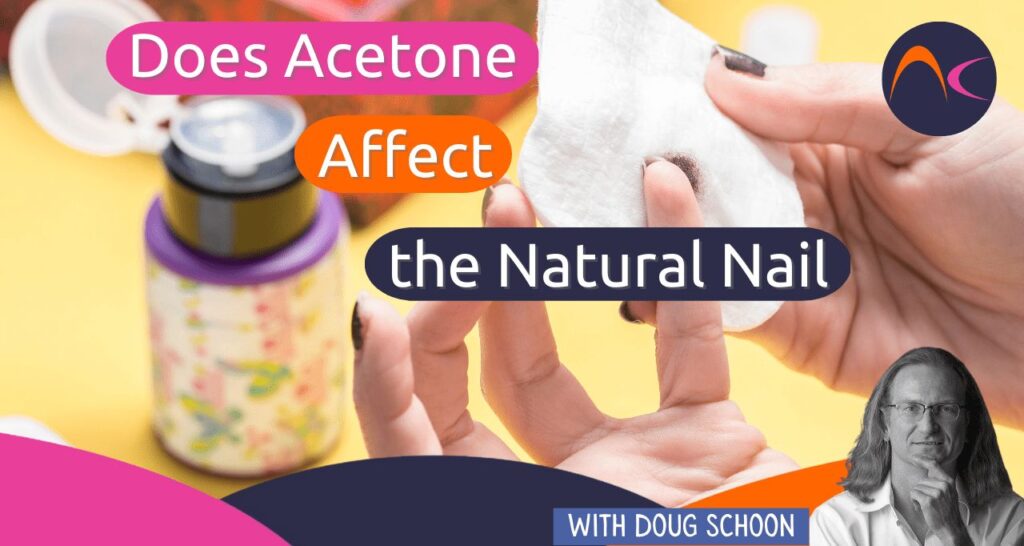We get lots of question addressing in regard to acetone such as these which we will address below:
- ¿Qué puede decirme sobre la acetona?
- Does it affect the natural nail?
- ¿La acetona daña de algún modo la uña natural?
Acetona: Un disolvente seguro
Much of what is said about acetone is based on a misunderstanding of this relatively safe substance. Acetone occurs naturally in our bodies in low concentrations. Much of what’s said about acetone is based on fear and misinformation.
If acetone smelled like essential oils, few would be concerned about it. Acetone’s strange odor and odd feel on the skin make many wary. When properly used, it’s a very safe solvent.
Agua y acetona: Similitudes y diferencias
Water and acetone are very similar in many ways. They are soluble in each other, which show they are similar. Why? The rule in nature is… “Like dissolves like”. Major chemical differences exist between oil and water, which is why they don’t mix.
Acetone and water also have similar effects on the nail plate, but there are differences as well. Both can absorb into the nail plate however acetone evaporates many times faster than water; that’s why it escapes much more quickly from the nail plate than water can, and why it doesn’t accumulate in the nail plate, it’s always evaporating away.
El agua quiere permanecer dentro de la placa. Una vez que la acetona es absorbida por la placa, una vez dentro, la acetona se mezcla con el agua para formar una mezcla compatible. Estos dos son tan altamente compatibles, que cuando la acetona se evapora de la placa de la uña, arrastra consigo un poco de agua de las capas superficiales superiores de la placa de la uña.
Deshidratadores de la superficie ungueal: Un efecto temporal
Lo mismo ocurre cuando se mezclan alcohol de quemar y agua; forman una mezcla compatible y parte del agua se evapora con el alcohol. Como la acetona elimina sobre todo el agua de la superficie, esto hace que la superficie de la placa de la uña esté mucho más seca, pero sólo temporalmente.
Rubbing alcohol or isopropyl alcohol or ethyl ether are examples of other solvents that may be safely used to temporarily remove water from the nail plate’s surface. Ethyl ether has also been used for many years as a nail plate surface dehydrator.
When used as directed these nail surface dehydrators will not damage the nail plate. That’s because the nail plate is only temporarily dehydrated and dehydration is easily reversed without any damage to the surface.
Water flows through the nail plate relatively quickly, these surface cells will only remain in this “drier condition” for somewhere in the range of thirty to forty minutes, depending on the person, or it could take several hours for the plate to completely rehydrate to normal levels.
One major and important difference between water and acetone is how each affects the “oil soluble” substances within the nail plate. Oils and waxes come from the lecho ungueal y los tejidos circundantes y constituyen normalmente el 5% de la lámina ungueal o menos.
Acetone’s Effect on Oil-Soluble Substances in the Nail Plate
La acetona puede disolver y eliminar estas sustancias de la superficie de la lámina ungueal. Esto se suma al aspecto seco creado por la pérdida de agua de la superficie. Estos aceites pueden sustituirse con un aceite penetrante de alta calidad.
Aun así, la pérdida de agua tiene un efecto mucho mayor sobre la placa para clavos. Acetone will remove more water than oil from the surface of the nail. When this occurs, we say the nail is dehydrated, but only the nail plate’s surface is temporarily dehydrated. That is a very important difference.
Efectos visibles de la deshidratación
Dehydrating the entire nail is very different from removing only surface water and oil. The latter is what acetone does and does well. We can literally see the effects of dehydration. Removing the water from the nail’s surface changes the surface appearance.
Light won’t easily transmit through the surface to illuminate the nail bed, nor will light reflect nicely off the surface to create what we refer to as “shine”. Instead the drier surface is uneven and lacks shine. This is because light is scattered in every direction from surfaces that aren’t smooth. This light scattering makes the nail plate appear whitish in places. Now this is really important to understand.
If a drop of water is placed on a dehydrated surface of a nail plate, the lost surface water is quickly replaced. The result is the “white” surface disappears as the surface layers are quickly re-hydrated, since this is the opposite of dehydrating it makes sense that it would happen.
El agua se absorbe en la placa de la uña a velocidades relativamente altas, por lo que, como he dicho antes, la uña no permanecerá deshidratada durante mucho tiempo. Incluso respirando sobre la placa de la uña se empezará a rehidratar la superficie.
If the white areas don’t disappear even after soaking the nails in water, how can the appearance be due to dehydration? Of course it can’t be and therefore it is not correct to say the nail is “dry”. Yet, this is said quite frequently and it creates confusion.
Mistakenly Blaming Visible Nail Damage on “Dryness”
Often time nail professionals incorrectly blame visible nail “damage” on being “dry nails”. This just shifts the responsibility for the problem in the wrong direction. Surface “damage” such as pits and scratches on the nail plate also scatter light in the same manner as surface dehydration. In other words, surface “damage” can also look much like “dehydration” to the untrained eye, but it is not the same. Water is the perfect test for dehydration. If water is applied onto the whitened areas and it doesn’t disappear, what does this say?
It must not be dry. It’s common to mistake surface roughness, pitting or other damage on the nail surface for so-called “dryness”. This surface whiteness is caused by scraping the nail plate and forcing residual pieces of nail coatings from the nail plate. This damage is completely avoidable, as discussed in later questions.


